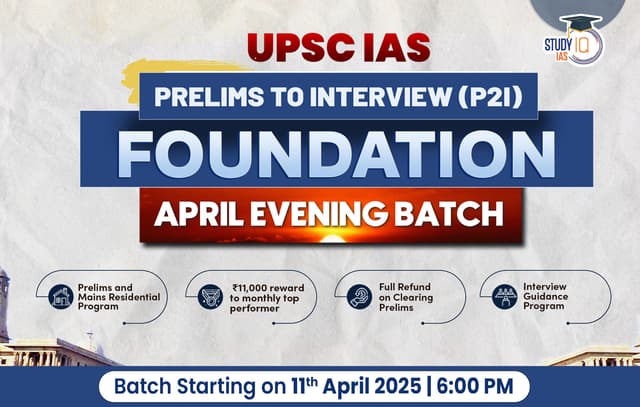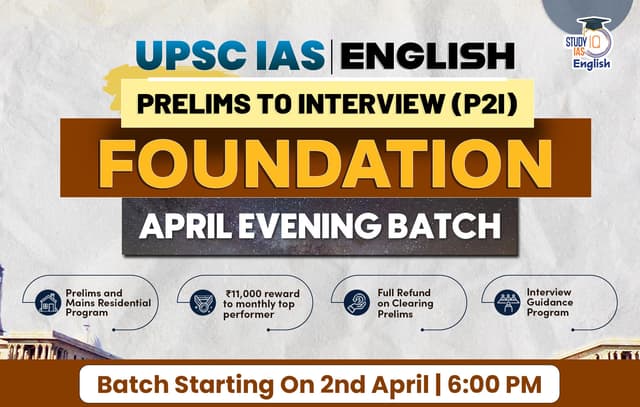Daily Quiz 4 February 2025
Quiz-summary
0 of 5 questions completed
Questions:
- 1
- 2
- 3
- 4
- 5
Information
- Click on – ‘Start Quiz’ button
- Solve Questions
- Click on ‘Next’ button
- Click on ‘Finish Quiz’ button
- Now click on ‘View Questions’ button – here you will see solutions and links.
- The test contains a total of 5 questions.
- Click on the most appropriate option to mark it as your answer.
- You will be awarded Two marks for each correct answer.
- You can change your answer by clicking on some other option.
- A Number list of all questions appears at the top side of the screen.
- You can access the questions in any order by clicking on the question number given on the number list.
- You can use rough sheets while taking the test.
- Do not use calculators, log tables, dictionaries, or any other printed/online reference material during the test.
- Do not click the button “Finish Quiz” before completing the test. A test once submitted cannot be resumed.
You have already completed the quiz before. Hence you can not start it again.
Quiz is loading...
You must sign in or sign up to start the quiz.
You have to finish following quiz, to start this quiz:
- 1
- 2
- 3
- 4
- 5
- Answered
- Review
-
Question 1 of 5
1. Question
1 pointsConsider the following statements with reference to Diamond Imprest Authorization Scheme:
- It has been introduced by the Department of Commerce, Union Ministry of Commerce and Industry.
- It allows the duty-free import of Natural Cut and Polished Diamonds, of more than 1 Carat.
Which of the statements given above is/are correct?
Correct
Answer: A
Explanation:
- Statement 1 is correct: Department of Commerce, Government of India has introduced the Diamond Imprest Authorization (DIA) Scheme in 2025, aiming to enhance the global competitiveness of India’s diamond sector. This scheme provides a streamlined mechanism for duty free import of Natural Cut and Polished Diamonds, and there by promoting value addition and boosting exports. The Scheme will be implemented with effect from 01.04.2025.
- Statement 2 is not correct: This scheme allows the duty-free import of Natural Cut and Polished Diamonds, of less than ¼ Carat (25 Cents). This scheme mandates export obligation with a value addition of 10%. All Diamond exporters holding Two Star Export House status and above and having US $15 Million exports per year, are eligible for availing the benefit under this scheme.
Incorrect
Answer: A
Explanation:
- Statement 1 is correct: Department of Commerce, Government of India has introduced the Diamond Imprest Authorization (DIA) Scheme in 2025, aiming to enhance the global competitiveness of India’s diamond sector. This scheme provides a streamlined mechanism for duty free import of Natural Cut and Polished Diamonds, and there by promoting value addition and boosting exports. The Scheme will be implemented with effect from 01.04.2025.
- Statement 2 is not correct: This scheme allows the duty-free import of Natural Cut and Polished Diamonds, of less than ¼ Carat (25 Cents). This scheme mandates export obligation with a value addition of 10%. All Diamond exporters holding Two Star Export House status and above and having US $15 Million exports per year, are eligible for availing the benefit under this scheme.
-
Question 2 of 5
2. Question
1 pointsConsider the following statements:
- Jute is a crop of humid tropical climates.
- All jute crops can thrive in water logging conditions.
- Laterite soils are best suited for jute cultivation.
- Jute is not included in the list of crops for which Minimum Support Price (MSP) is announced.
How many of the above statements are correct?
Correct
Answer: A
Explanation:
- Raw jute being biodegradable and annually renewable source, it is considered as an environment friendly crop.
- Statement 1 is correct: Jute is a crop of humid tropical climates. It thrives well in areas with well distributed rainfall of 2,500 mm spread over vegetative growth period of the crop with no cloudiness. Locations with a mean rainfall of <1,000 mm, incessant rainfall and water logging are not suitable for its cultivation. For better growth, a mean maximum and minimum temperature of 34℃ and 15℃ and a mean relative humidity of 65% are required. Temperatures below 15℃ and above 43℃ during growth are not suitable for jute crop.
- Statement 2 is not correct:Corchorus olitorius (Tossa jute) cannot withstand water logging, however, C. capsularis (White jute) can withstand water logging, but its fibre quality is impaired with prolonged water stagnation. At a temperature below 10℃, no germination occurs in both species. C. capsularis can withstand higher temperatures at germination (up to 32oC), while C. olitorius is sensitive to such high temperatures.
- Statement 3 is not correct: Jute can be raised on all kinds of soils from clay to sandy loam, but loamy alluvial are best suited. Laterite and gravel soils are not suitable for this crop. The new grey alluvial soils of good depth, receiving silt from the annual floods are the best for jute cultivation. A soil pH of 5.0-7.4 is within the tolerable limit of soil reaction. Soils with acidic pH (<4.5), effective soil depth <50 cm, electrical conductivity >2 dS/m and exchangeable sodium percentage >15 are not suitable for the crop. The crop is raised successfully on old alluvial soils of Bihar, mild acidic soils of Assam, Orissa, and light alkaline soils of tarai districts of Uttar Pradesh. It has been observed that clay loam for C. capsularis and sandy loam for C.olitorius are most suitable soil types.
Statement 4 is not correct: Jute is included in the list of crops for which Minimum Support Price (MSP) is announced. The Cabinet Committee on Economic Affairs (CCEA) has fixed the Minimum Support Price (MSP) of raw jute for 2025-26 marketing season at ₹5,650 per quintal. The new price is an increase of ₹315 per quintal over the price in 2024.
Incorrect
Answer: A
Explanation:
- Raw jute being biodegradable and annually renewable source, it is considered as an environment friendly crop.
- Statement 1 is correct: Jute is a crop of humid tropical climates. It thrives well in areas with well distributed rainfall of 2,500 mm spread over vegetative growth period of the crop with no cloudiness. Locations with a mean rainfall of <1,000 mm, incessant rainfall and water logging are not suitable for its cultivation. For better growth, a mean maximum and minimum temperature of 34℃ and 15℃ and a mean relative humidity of 65% are required. Temperatures below 15℃ and above 43℃ during growth are not suitable for jute crop.
- Statement 2 is not correct:Corchorus olitorius (Tossa jute) cannot withstand water logging, however, C. capsularis (White jute) can withstand water logging, but its fibre quality is impaired with prolonged water stagnation. At a temperature below 10℃, no germination occurs in both species. C. capsularis can withstand higher temperatures at germination (up to 32oC), while C. olitorius is sensitive to such high temperatures.
- Statement 3 is not correct: Jute can be raised on all kinds of soils from clay to sandy loam, but loamy alluvial are best suited. Laterite and gravel soils are not suitable for this crop. The new grey alluvial soils of good depth, receiving silt from the annual floods are the best for jute cultivation. A soil pH of 5.0-7.4 is within the tolerable limit of soil reaction. Soils with acidic pH (<4.5), effective soil depth <50 cm, electrical conductivity >2 dS/m and exchangeable sodium percentage >15 are not suitable for the crop. The crop is raised successfully on old alluvial soils of Bihar, mild acidic soils of Assam, Orissa, and light alkaline soils of tarai districts of Uttar Pradesh. It has been observed that clay loam for C. capsularis and sandy loam for C.olitorius are most suitable soil types.
Statement 4 is not correct: Jute is included in the list of crops for which Minimum Support Price (MSP) is announced. The Cabinet Committee on Economic Affairs (CCEA) has fixed the Minimum Support Price (MSP) of raw jute for 2025-26 marketing season at ₹5,650 per quintal. The new price is an increase of ₹315 per quintal over the price in 2024.
-
Question 3 of 5
3. Question
1 pointsThe term “Principal Purpose Test (PPT),” often seen in the context of international taxation, refers to:
Correct
Answer: A
Explanation:
- Option A is correct: Action 6 of Base Erosion and Profit Shifting (BEPS) introduced the principal purpose test (PPT) as one of the Minimum Standards to be implemented by the countries participating in the BEPS Inclusive Framework. The PPT has also been introduced in the Multilateral Instrument (MLI) in force since 1 July 2018.
- The PPT is part of international tax rules aimed at preventing misuse of tax treaties. Under the BEPS framework, the PPT checks whether a business arrangement is genuinely commercial or created mainly to avoid taxes. If the primary purpose is tax-saving, treaty benefits can be denied.
- The PPT aims to tackle treaty abuse including treaty shopping and it is based to some extent in the guiding principle of the 2003 OECD Commentary. However, unlike the guiding principle that was not extensively followed by countries, the PPT as one of the BEPS 4 minimum standards is at the time of writing followed by 129 countries.
Incorrect
Answer: A
Explanation:
- Option A is correct: Action 6 of Base Erosion and Profit Shifting (BEPS) introduced the principal purpose test (PPT) as one of the Minimum Standards to be implemented by the countries participating in the BEPS Inclusive Framework. The PPT has also been introduced in the Multilateral Instrument (MLI) in force since 1 July 2018.
- The PPT is part of international tax rules aimed at preventing misuse of tax treaties. Under the BEPS framework, the PPT checks whether a business arrangement is genuinely commercial or created mainly to avoid taxes. If the primary purpose is tax-saving, treaty benefits can be denied.
- The PPT aims to tackle treaty abuse including treaty shopping and it is based to some extent in the guiding principle of the 2003 OECD Commentary. However, unlike the guiding principle that was not extensively followed by countries, the PPT as one of the BEPS 4 minimum standards is at the time of writing followed by 129 countries.
-
Question 4 of 5
4. Question
1 pointsConsider the following statements with reference to the Yala Glacier:
- It is the only glacier in the entire Himalayas to be included in the Global Glacier Casualty List.
- It is located in the Tibet region of China.
Which of the statements given above is/are not correct?
Correct
Answer: B
Explanation:
Statement 1 is correct and statement 2 is not correct: Yala glacier, one of Nepal’s most extensively studied glaciers, is expected to vanish by 2040s. It is the only glacier in the entire Himalayas to be included in the Global Glacier Casualty List, a project launched in 2024 through a collaboration between Rice University, University of Iceland, Iceland Glaciological Society, World Meteorological Organization (WMO), World Glacier Monitoring Service, and UNESCO.
Incorrect
Answer: B
Explanation:
Statement 1 is correct and statement 2 is not correct: Yala glacier, one of Nepal’s most extensively studied glaciers, is expected to vanish by 2040s. It is the only glacier in the entire Himalayas to be included in the Global Glacier Casualty List, a project launched in 2024 through a collaboration between Rice University, University of Iceland, Iceland Glaciological Society, World Meteorological Organization (WMO), World Glacier Monitoring Service, and UNESCO.
-
Question 5 of 5
5. Question
1 pointsWhich one of the following is correct with reference to the Mannan community, recently seen in the news?
Correct
Answer: A
Explanation:
- Option (A) is correct: There are only two tribal groups in India who have a king as their ruler, one in Tripura and the other in Kerala that are mannan tribes in Idukki district.
- The term ‘Mannan’ is a combination of ‘Manna’ (earth) and Manusian (man), which means ‘the sons of the soil’. Today, the Mannans live in 46 settlements, most of them in Idukki district, although a few of them are also in Ernakulam and Thrissur districts.
Mostly engaged as farm labourers and daily wagers, the Mannans have long attracted media attention for their distinctive customs and traditions – among them a unique system of self-governance under their king. In the clan, the king’s advice still holds significant sway over the kudis (settlements).
Incorrect
Answer: A
Explanation:
- Option (A) is correct: There are only two tribal groups in India who have a king as their ruler, one in Tripura and the other in Kerala that are mannan tribes in Idukki district.
- The term ‘Mannan’ is a combination of ‘Manna’ (earth) and Manusian (man), which means ‘the sons of the soil’. Today, the Mannans live in 46 settlements, most of them in Idukki district, although a few of them are also in Ernakulam and Thrissur districts.
Mostly engaged as farm labourers and daily wagers, the Mannans have long attracted media attention for their distinctive customs and traditions – among them a unique system of self-governance under their king. In the clan, the king’s advice still holds significant sway over the kudis (settlements).
Results
0 of 5 questions answered correctly
Your time:
Time has elapsed
You have reached 0 of 0 points, (0)
| Average score |
|
| Your score |
|
Categories
- Not categorized 0%
| Pos. | Name | Entered on | Points | Result |
|---|---|---|---|---|
| Table is loading | ||||
| No data available | ||||
Sharing is caring!

 Daily Quiz 09 April 2025
Daily Quiz 09 April 2025
 Daily Quiz 08 April 2025
Daily Quiz 08 April 2025





















